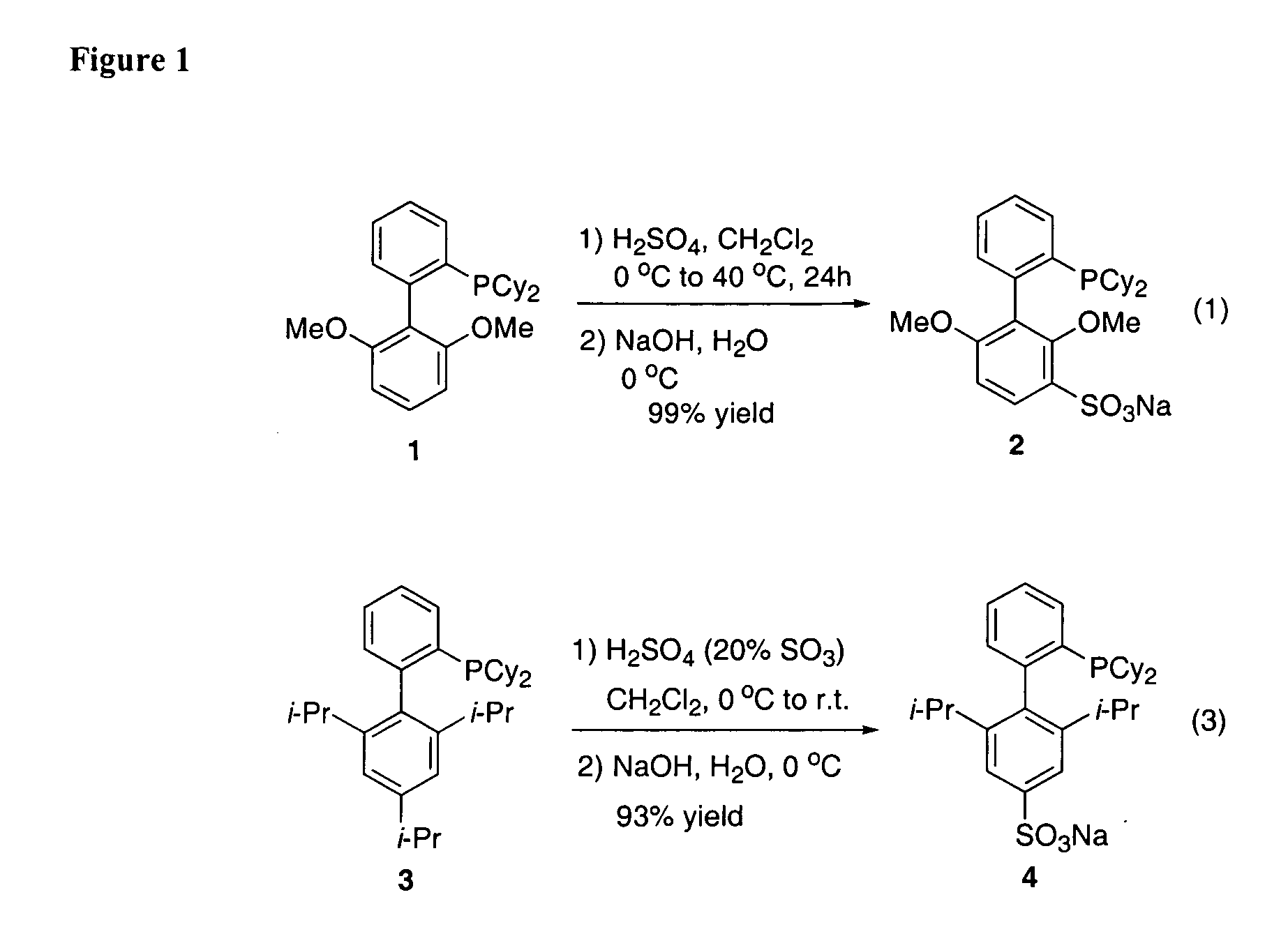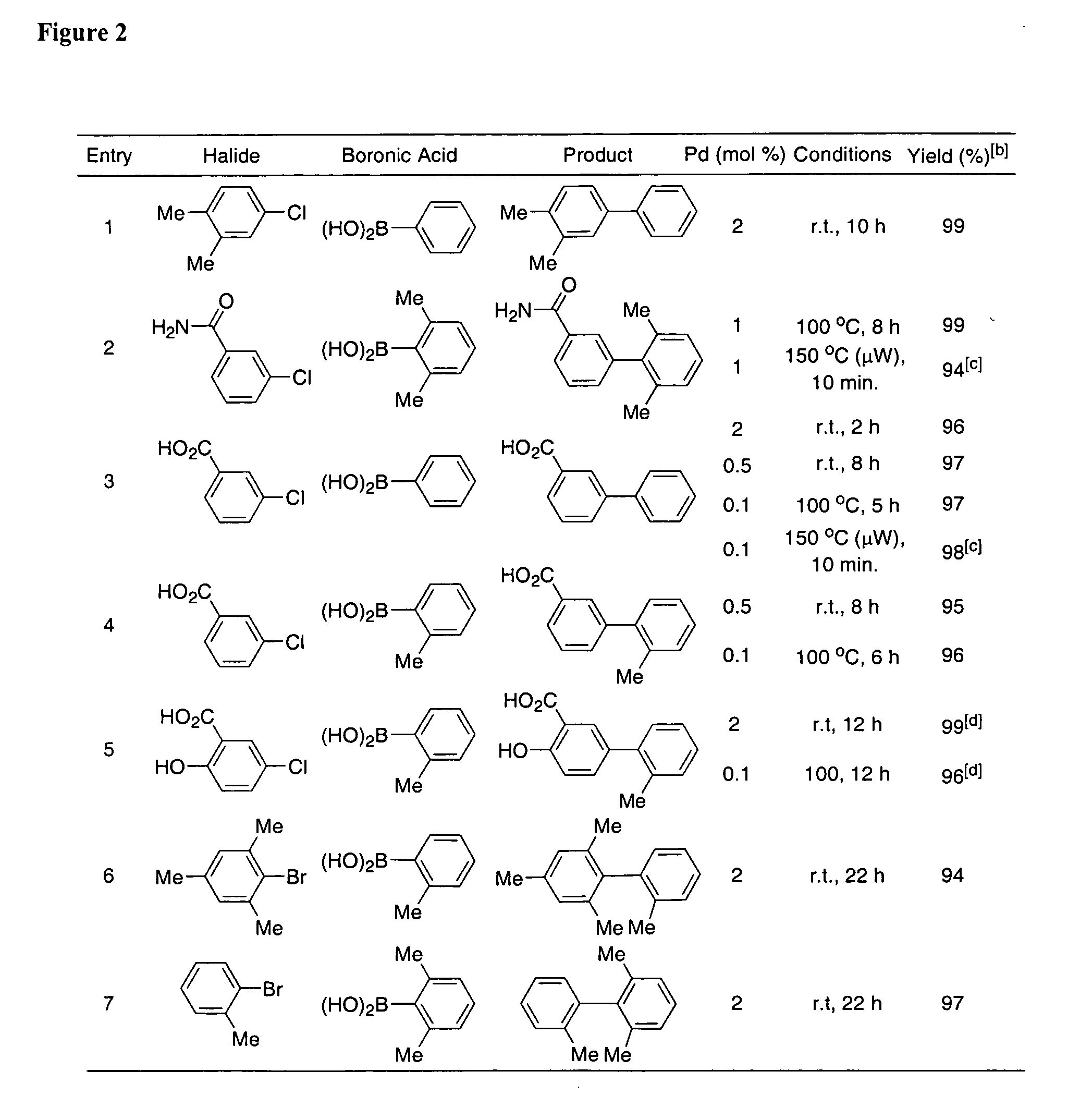Transition-metal-catalyzed carbon-nitrogen and carbon-carbon bond-forming reactions
a technology of carbon-nitrogen and carbon-carbon bonding, which is applied in the preparation of organic compounds, physical/chemical process catalysts, and preparation of amino compounds, etc., can solve the problem of limiting the rate of oxidative addition in the accepted mechanism of coupling reactions, higher temperature, and longer reaction times
- Summary
- Abstract
- Description
- Claims
- Application Information
AI Technical Summary
Benefits of technology
Problems solved by technology
Method used
Image
Examples
example 1
General Experimental Details
[0329] Reagents. Pd(OAc)2 was obtained from Englehard and used without further purification. Dichloromethane was purchased from J. T. Baker in CYCLE-TAINER® solvent delivery kegs, which were vigorously purged with argon for 2 h, and further purified by passing the solvent through two packed columns of neutral alumina and copper (II) oxide under argon pressure. All other reagents were purchased from commercial sources and used without further purification.
[0330] Analytical methods. All reactions were carried out under an argon atmosphere. IR spectra were obtained on a Perkin-Elmer Model 2000 FT-IR using NaCl plates (thin film). 1H NMR and 13C NMR spectra were recorded on a Bruker 400 Mhz NMR with chemical shifts reported in ppm relative to the residual deuterated solvent or the internal standard tetramethylsilane. Yield refers to isolated yields of compounds greater than 95% purity as determined by capillary gas chromatography (GC) and proton Nuclear Mag...
example 2
Preparation of Water-Soluble Ligand 2 (See FIG. 1, Equation 1)
[0331] To an oven-dried 25 mL round bottom flask equipped with a Teflon-coated magnetic stir bar and rubber septum was added 2-dicyclohexylphosphino-2′6′dimethoxybiphenyl (5.13 g, 12.5 mmol) and CH2Cl2 (5 mL). The solution was cooled to 0° C. using an ice / water bath and then concentrated H2SO4 (32.5 mL, 625 mmol) was added dropwise. The solution slowly turned yellow in color. The solution was heated to 40° C. in a preheated oil bath and was allowed stir for 24 h. At this time it was cooled to 0° C. using an ice / water bath and crushed ice (˜50 g) was added. The solution turned cloudy and white in color. An aqueous solution of NaOH (6.0 M, ˜200 mL) was then added dropwise to the cooled solution until it became neutral (pH ˜7.0 as judged by pH paper). The aqueous solution was extracted with CH2Cl2 (3×300 mL) and concentrated under reduced pressure to give a light yellow solid. The crude material was then dissolved in a mini...
example 3
General Procedure for Suzuki-Miyaura Coupling in Water (See FIG. 2)
[0332] A disposable tube with a screw cap, Teflon septum and stir bar was charged with Pd(OAc)2 (2.2 mg, 0.010 mmol, 1 mol %), sodium 2-dicyclohexylphosphino-2′,6′-dimethoxybiphenyl-3′-sulfonate (10.0 mg, 0.0200 mmol, 2 mol %), aryl halide (1.00 mmol), boronic acid (1.20-1.50 mmol) and K2CO3 (276-690 mg, 2.00-5.00 mmol). The tube was evacuated and back-filled with argon (this was repeated two additional times). Degassed water (1.5-3.0 mL, sonicated under vacuum for 2 min) was added and the reaction mixture was allowed to stir at the noted temperature or submitted to microwave irradiation using a CEM Discover® LabMate microwave (300 W, 150° C., with cooling to optimize the power). After cooling to room temperature, the hydrophilic products were isolated by acidifying the reaction mixture with HCl (2.0 M) to pH˜5 and extraction with ethyl acetate or diethyl ether. The organic layer was dried over anhydrous MgSO4, filt...
PUM
| Property | Measurement | Unit |
|---|---|---|
| mol % | aaaaa | aaaaa |
| temperature | aaaaa | aaaaa |
| temperature | aaaaa | aaaaa |
Abstract
Description
Claims
Application Information
 Login to View More
Login to View More - R&D
- Intellectual Property
- Life Sciences
- Materials
- Tech Scout
- Unparalleled Data Quality
- Higher Quality Content
- 60% Fewer Hallucinations
Browse by: Latest US Patents, China's latest patents, Technical Efficacy Thesaurus, Application Domain, Technology Topic, Popular Technical Reports.
© 2025 PatSnap. All rights reserved.Legal|Privacy policy|Modern Slavery Act Transparency Statement|Sitemap|About US| Contact US: help@patsnap.com



